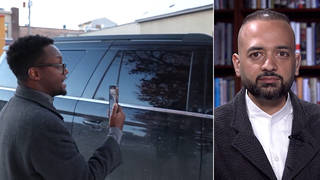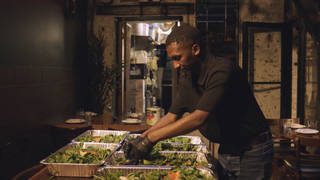
Guests
- Mansoor Adayfiformer Guantánamo detainee who was imprisoned without charge for 14 years and seven months before being released in 2016 to Serbia. He is the Guantánamo Project coordinator at CAGE, an organization that advocates on behalf of victims of the “war on terror,” and outreach coordinator for the Guantánamo Survivors Fund.
As Republican Florida Governor Ron DeSantis plans to run for president in 2024, his time at Guantánamo is coming under scrutiny. Prior to entering politics, DeSantis served in the Navy as an attorney, first at the U.S. prison at the Guantánamo Bay prison in Cuba and later in Iraq. Former Guantánamo prisoner Mansoor Adayfi says DeSantis personally witnessed him being force-fed and tortured, and other prisoners have backed up Adayfi’s account. He joins us from his home in Belgrade for his first television interview about DeSantis’s role at Guantánamo. “While I was screaming, yelling because I couldn’t breathe … he was actually laughing, looking at the other officers and smiling,” Adayfi says of DeSantis. “He wasn’t involved directly in the force-feeding. I didn’t see him give any orders to the guards. But he was there, supervising, watching.” Adayfi was imprisoned without charge for 14 years and seven months before being released in 2016 to Serbia. In 2021, he published a memoir titled Don’t Forget Us Here: Lost and Found at Guantánamo.
Transcript
AMY GOODMAN: This is Democracy Now!, democracynow.org, The War and Peace Report. I’m Amy Goodman.
As former president and 2024 presidential candidate Donald Trump prepares to be arrested in New York on Tuesday, we turn now to look at a growing controversy about one of Trump’s likely presidential opponents. That’s Florida Governor Ron DeSantis, widely expected to seek the Republican nomination for president.
Prior to entering politics, DeSantis served in the Navy as an attorney at the U.S. prison at Guantánamo and in Fallujah, Iraq. DeSantis’s time at Guantánamo is coming under scrutiny after a former prisoner, named Mansoor Adayfi, revealed that DeSantis had personally witnessed him being force-fed and tortured. Other prisoners have backed up Adayfi’s account. Last month, DeSantis denied authorizing force-feeding at Guantánamo.
PIERS MORGAN: The Washington Post did a big deep dive on this today, actually, about what you did out there. One of the things they said was that you authorized the use of force-feeding, that somebody —
GOV. RON DESANTIS: That’s not true. Yeah, that’s not true. Yeah. Any of the stuff that people have —
PIERS MORGAN: Just to finish —
GOV. RON DESANTIS: OK.
PIERS MORGAN: Force-feeding the detainees who were on hunger strike. Was that true?
GOV. RON DESANTIS: So, I was a — I was a junior officer. I didn’t have authority to authorize anything. There may have been a commander that would have done feeding if someone was going to die. But that was not something that I would have even had authority to do.
PIERS MORGAN: So, that’s wrong?
GOV. RON DESANTIS: Yeah, yeah, absolutely.
AMY GOODMAN: That was Ron DeSantis last month in an interview with Piers Morgan. But in an interview five years ago, in 2018, DeSantis admitted to CBS Miami that he had authorized force-feeding.
REP. RON DESANTIS: I was a legal adviser.
JIM DEFEDE: For those that were doing —
REP. RON DESANTIS: The things that would happen is — the thing you notice the day you get down there is, for these detainees, the jihad was still ongoing.
JIM DEFEDE: Right.
REP. RON DESANTIS: And they would wage jihad any way they can. Now, they’re in a facility, so it’s limited. But some of the things they would do, they would do hunger strikes. And you actually had three detainees that committed suicide with hunger strikes. So, everything at that time was legal in nature one way or another. So, the commander wants to know, “Well, how do I combat this?” So one of the jobs of the legal adviser is to be like, “Hey, you actually can force-feed. Here’s what you can do. Here’s kind of the rules of that.”
AMY GOODMAN: That was Ron DeSantis in 2018 as he was running for governor in Florida.
Well, with DeSantis expected to soon launch a run for the White House, we’re joined by former Guantánamo prisoner Mansoor Adayfi. At the age of 18, he left his home in Yemen to do research in Afghanistan. Shortly before he was scheduled to return home, he was kidnapped by Afghan warlords and sold to the CIA after the September 11th attacks. He was jailed and tortured in Afghanistan, then transported to the U.S. military prison at Guantánamo in 2002, where he was held without charge for 14 years, many of those years in solitary confinement. Mansoor Adayfi now joins us from his home in Belgrade, [Serbia]. In 2021, he published a memoir titled Don’t Forget Us Here: Lost and Found at Guantánamo.
Mansoor Adayfi, welcome back to Democracy Now!
MANSOOR ADAYFI: Hi, Amy. Nice to see you again. Good morning, America.
AMY GOODMAN: It’s great to have you with us. You’re actually speaking to the world right now at democracynow.org. You were Detainee 441. Explain your connection to the current Florida governor, DeSantis.
MANSOOR ADAYFI: Yeah, that’s back to 2006. As you know, like — let me give a brief introduction to why we went on hunger strike in the first place. As you know, we were transferred to Guantánamo, spent years without — without any kind — like, until now, without kind of, like, charges or rights and so on. By the end of 2002, General Geoffrey Miller arrived, and he turned the Guantánamo into a experimenting lab. And the situation got only worse every month and every year.
By 2005, we managed to organize like a mass hunger strike, that embarrassed the U.S. government. The camp administration at that time tried to negotiate with us to stop the hunger strike so they can improve the living condition in the camp. We agreed. But it was just they were buying time.
By the beginning of 2006, a new medical team, a new camp staff arrived. One of them was a young — a young, handsome officer, who came to talk to us and told us he was there to ensure that we were being treated humanely. And we talked to him about why we were on hunger strike, what were our demands. It wasn’t jihad, as he said, like. And, you know, what people always try to turn our actions in Guantánamo as like in jihad or al-Qaeda activist cell, that what used to tell us all the time. So, these were our demands. Stop the torture. We were asking for them to improve the living condition in the camp. And he was talking to us and assured us that everything will change, and he will make sure that we be treated humanely.
Only two months, only like, I think, even less, only even less two months later, we were dragged to block — solitary confinement, different camp, different blocks. A new medical team arrived, and they start forcing feed us. And I’m [inaudible] no problem with the force-feeding. They used the force-feeding as a mean of torture. You know, I was taken to a nonformal block in Camp 2. I was tied to a force-feeding chair. Like, I couldn’t move at all. I could only breathe. Guards bring piles of Ensure. And they started with the nurses pouring can of Ensure one after another, like the only way like you eat.
So, during the feeding, a group of officers arrived with the interpreters, with the interrogators, camp staff, medical staff. They were behind the fence. And I saw one of them was Ron DeSantis in a military uniform. And he was — while I was screaming, yelling, because I couldn’t breathe, of the Ensure, and was like — I was bleeding, because they really insert the thick tube through my nose. So, I was, like, calling them, asking, and he was actually laughing, looking at the other officers, and smiling. So, this is my first encounter — second encounter with the Ron DeSantis. The first, before the force-feeding, he came to talk to us and other prisoners. Second time I saw him like twice while on the force-feeding.
And I would like to highlight really important things here. He was there — he wasn’t there, like, to give orders. He wasn’t involved directly in the force-feeding. I didn’t see him give any orders to the guards. But he was there, like, supervising, watching. When I asked other prisoners who were also in the force-feeding if they saw him, they said yes. One of them, at least he told me — he sent me a message. He said he was there, too.
AMY GOODMAN: Mansoor, we are also showing images of your remarkable artwork, your drawing of being force-fed, as you speak. But I wanted to turn right now to another former Guantánamo prisoner, who Democracy Now! reached last week, Ahmed Ould Abdel Aziz, who also remembers Ron DeSantis at Guantánamo. He spoke to us from Mauritania.
AHMED OULD ABDEL AZIZ: DeSantis, he was there, that person called DeSantis, because we didn’t recognize his name until we saw him in the media, and then we heard about he is now working in the Congress, a guard who was working, you know, a very long time ago. For us, he’s a guard, you know. For the government, he’s a lawyer, and he came there. But he’s doing the same thing as a guard, because he was sided — he was siding with the guards. He was siding with the administration there. He was part of that. He was a link of that chain, a chain of involvers, people who were involved with the injustices, wrongdoing and mistreatment of detainees, putting people and detainees in degrading conditions, degrading locales, because many of these blocks were not suitable for animals, not, say, about humans.
AMY GOODMAN: So, that’s former Guantánamo prisoner Ahmed Ould Abdel Aziz, speaking from Mauritania. He was released in 2015. And, Mansoor, you also contacted former Guantánamo prisoners via WhatsApp to see if they remembered Ron DeSantis. For our TV viewers, we’re showing the screenshot of one of the people who responded to you, who wished to remain anonymous. His message says, in translation, quote, “Yes, I remember him. He was in detention with a group of officers who hurt and tortured us a lot. May Allah publish them all.” I assume it means “May Allah punish them all.” Can you talk further about how the force-feeding felt, and if there were any guards who were doing this to you, or the people — you can tell us who they were — who were putting in these tubes, who objected?
MANSOOR ADAYFI: You know, there’s a difference between the force-feeding and using the force-feeding as a mean of torture. I spent years on force-feeding. Other, some prisoners spent between two to 15 years on force-feeding daily. We get like — usually, we get like twice a day, in the morning, in the afternoon or night. Also, during Ramadan, they will do it like after sunset. You know, there was, like, medical professionals. There were, like, nurses, doctors.
But in 2006 — and if you go to — if readers go to my book, I talk particularly about what happened in 2006 was one of the worst years in Guantánamo, where DeSantis was there. They start punishing — they started by punishing prisoners in Camp 5. Then they tortured the hunger strikers by force-feeding. Also, Camp 4, a medium-security camp, was raided, and detainees were shot and hospitalized. Three detainees died this year. Then, by the end of 2006, a new camp was opened, like Camp 6.
So, in 2006, when Ron DeSantis was there during the torture by the force-feeding, they really brought thick tubes, called 18 French or 25 French, with the metal tip, and they just push it in our nose. Guards used to do that, too, because guards and camp staff — and medical staff, sorry, were there doing the force-feeding. I got fed five times a day. They left me all night on the force-feeding chair. And they give us some kind of laxative liquid in the nutrition liquid. So, while sitting on the force-feeding chair, we would [bleep] on ourselves, and they left us like that. When they moved us to solitary confinement again, they left us only with shorts, really cold cell. And the second day, they would start again, like leave us for hours. We couldn’t last, some, for three days, five days, and we had to stop.
So, the Ensure, they brought, like, boxes, five boxes or more, and the force-feeding bag, what they just pour in soup can, Ensure, one after another, I felt I was really drowning. On one of the force-feeding, when I was, like, throwing up, yes, Ron DeSantis was there behind the fence, and camp officers, they were behind the fence wen I was throwing up. The Ensure was too much in my stomach, so I threw at them. And they jumped back. They were cleaning themselves, looking at me. So I felt I did something at least, you know, worth it. So, on one of the force-feeding, while I was throwing up, the tube literally came out from my mouth. I remember the nurse grabbed the tube and was like, “Start to eat. You have to start to eat.” So, that lasted for me for five days, and I had no choice. Like, I couldn’t last. Either I die or stop the hunger strike. And we stopped.
I was force-fed again in 2009, 2013, other, but that time they did it professionally, and we had no problem. We could cooperate, cooperated with them. The only time that force-feeding was used as torture in 2006. There was also another years where some medical teams, they will try to pressure us, you know, like, by — to stop the hunger strike, but not as bad as in 2006.
AMY GOODMAN: In 2006, lawyers for another prisoner argued that the military made the force-feeding process unnecessarily painful and humiliating to break the hunger strike. At the time, something like a hundred of the prisoners were on hunger strike. I wanted to ask you why you think that Ron DeSantis, now the governor of Florida, has hardly mentioned his time, his experience at Guantánamo in his new book, The Courage to Be Free, and also ask you about his time in Fallujah, which is very interesting, going back to Iraq. You have — he arrived in 2007, right after he was at Guantánamo, during the surge. According to the Tampa Bay Times, DeSantis served as a senior legal adviser to the SEAL who commanded Special Operations Task Force-West in Fallujah, Navy Captain Dane Thorleifson. Talk about the legacy of Fallujah.
MANSOOR ADAYFI: First of all, he didn’t mention much about his time in Guantánamo, because we knew he was part of JTF and he was a legal adviser. And if you ask me, I think DeSantis is a cruel person. I believe that his mission there was a cover-up, to cover up what happened in 2006.
So, about Fallujah, I don’t think I’m in a position to comment on his time there, but for what I have read and seen, that — we all know what happened in Fallujah, like death of civilians, using depleted uranium and so on. So, I would like to say one word to Americans: Just watch out from that person. You know, he’s someone who bend the truth to serve his own political interest.
AMY GOODMAN: Mansoor, we’re going to do a second part of this interview and post it at democracynow.org. You just wrote a “Comment Is Free” op-ed piece in The Guardian about a Biden administration decision around the artwork of the Guantánamo prisoners, and we’re going to talk about that and also show more of your images that you drew while in Guantánamo. Yes, Mansoor Adayfi is a former Guantánamo prisoner, Detainee 441, imprisoned without charge for 14 years and seven months, before being released in 2016 to Serbia. We spoke to him in Belgrade. His memoir is titled Don’t Forget Us Here: Lost and Found at Guantánamo.
That does it for our show. Democracy Now! currently accepting applications for a digital fellow. Go to democracynow.org for more information. I’m Amy Goodman. Thanks so much for joining us.











Media Options